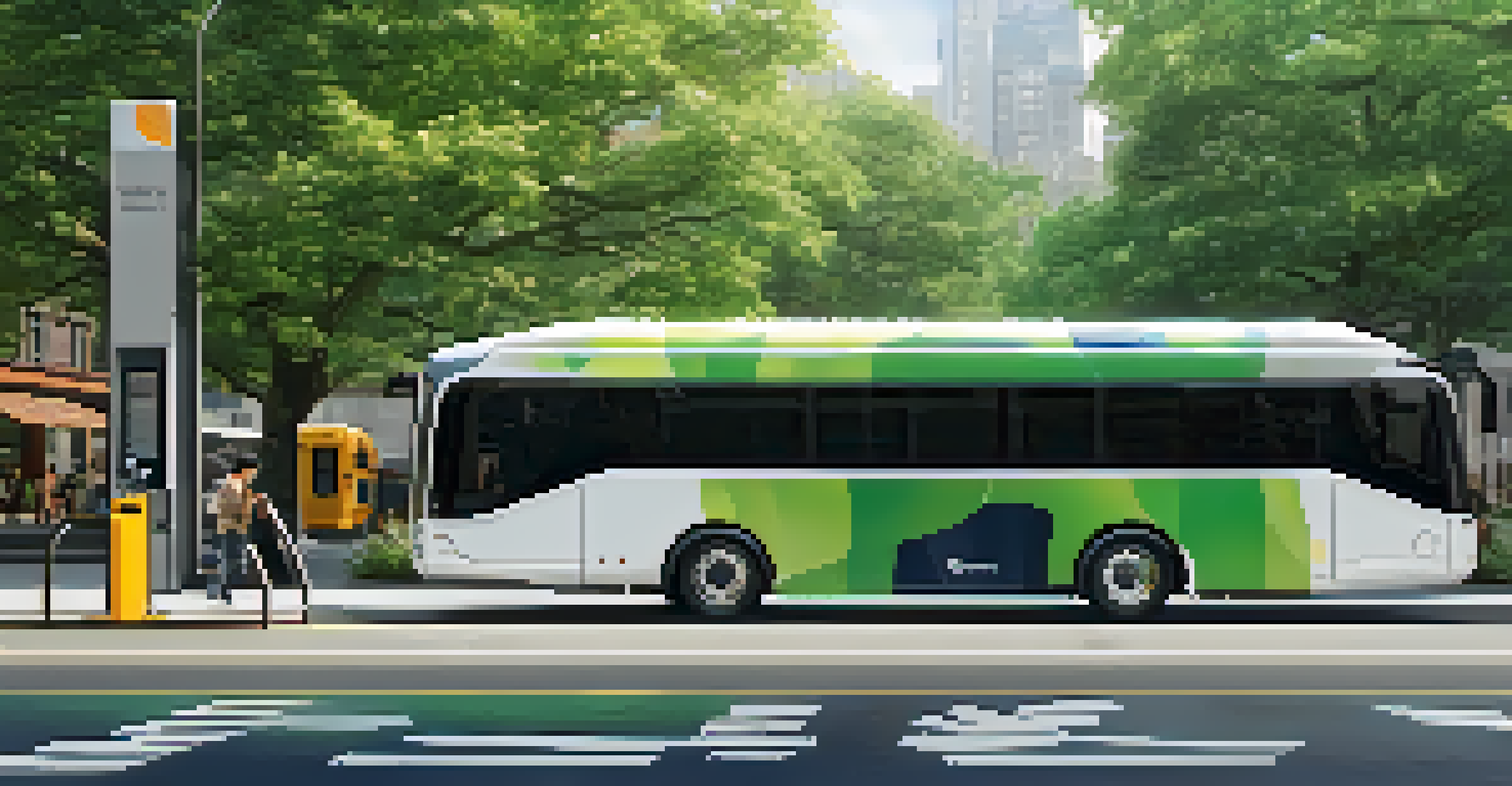Exploring Electric Buses: Redefining Public Transit in NYC

The Rise of Electric Buses in Public Transit
In recent years, electric buses have begun to reshape public transit, particularly in bustling cities like New York. These eco-friendly vehicles offer a cleaner alternative to traditional diesel buses, which have long been a staple of urban transport. As cities grapple with pollution and climate change, electric buses present a viable solution to reduce emissions and improve air quality.
Electric buses represent a significant step towards sustainable public transport, reducing emissions and improving air quality in our cities.
New York City has taken significant steps towards integrating electric buses into its fleet, with ambitious plans for expansion. The transition to electric is not only about environmental benefits; it also represents a shift in public perception towards more sustainable modes of transportation. The excitement surrounding this innovation is palpable, and NYC is leading the charge in this transformation.
As we delve into the world of electric buses, we’ll explore how they operate, the challenges they face, and their potential to enhance the commuting experience for millions of New Yorkers. With advancements in technology and increasing investments, the future of public transit in NYC looks brighter and greener than ever.
Environmental Benefits of Electric Buses
One of the most compelling reasons for the adoption of electric buses is their positive impact on the environment. Unlike their diesel counterparts, electric buses produce zero tailpipe emissions, significantly reducing the levels of harmful pollutants in the air. This is particularly crucial in a densely populated city like New York, where air quality can suffer due to heavy traffic.

Moreover, electric buses contribute to the fight against climate change by lowering greenhouse gas emissions. The reduction in reliance on fossil fuels not only helps in preserving the environment but also aligns with global sustainability goals. For residents, cleaner air means better health outcomes and an improved quality of life.
Electric Buses Enhance Urban Transit
Electric buses are transforming public transit in cities like NYC by offering cleaner, more sustainable transportation options.
Cities around the world are beginning to notice the benefits of electric buses, and NYC is no exception. As more electric buses hit the streets, we can expect to see a tangible difference in the air quality, reminding us that every little change can lead to significant improvements in our daily lives.
Cost Considerations and Economic Impacts
While the initial investment in electric buses may be higher than traditional buses, the long-term savings can be substantial. Electric buses have lower operating costs, primarily due to reduced fuel and maintenance expenses. As battery technology continues to advance, these costs are expected to decrease even further, making electric buses an economically sound choice for transit authorities.
Investing in electric buses is not just about cleaner air; it's about creating jobs and stimulating the economy while protecting our planet.
Additionally, the shift to electric buses can create jobs in the green technology sector. From manufacturing to maintenance, a growing electric bus industry can provide new employment opportunities for New Yorkers. This not only bolsters the local economy but also stimulates innovation and workforce development in sustainable technologies.
Ultimately, investing in electric buses may prove to be a wise financial decision for NYC, as it paves the way for a more sustainable future while supporting the local economy. The long-term benefits of cleaner, more efficient public transit can outweigh the initial costs, making the switch an attractive option.
Technological Innovations Driving the Change
Electric buses are becoming increasingly sophisticated, thanks to rapid advancements in technology. Modern electric buses are equipped with features like regenerative braking, which captures and reuses energy, enhancing efficiency. Additionally, many models now include smart technology that provides real-time data on battery life and performance, allowing for efficient fleet management.
Charging infrastructure is also evolving, with the emergence of fast-charging stations strategically located throughout the city. This ensures that electric buses can remain operational throughout the day without long downtime for charging. The integration of smart grid technology further enhances this process, allowing for optimized energy use.
Environmental and Economic Benefits
The adoption of electric buses significantly reduces air pollutants and greenhouse gas emissions while also providing long-term cost savings for transit authorities.
These innovations not only improve the performance of electric buses but also enhance the overall experience for passengers. With quieter rides and smoother acceleration, commuters can enjoy a more comfortable journey while contributing to a greener city.
Challenges Facing Electric Bus Implementation
Despite the many advantages of electric buses, the transition is not without its challenges. One major hurdle is the current charging infrastructure, which needs to be expanded to support a growing fleet of electric vehicles. Ensuring that sufficient charging stations are available and conveniently located is essential for the successful implementation of electric buses.
Another concern is the range of electric buses, which can be limited compared to traditional buses. Although advancements in battery technology are addressing this issue, range anxiety can still be a deterrent. Transit authorities must carefully plan routes and schedules to maximize the efficiency of electric buses while ensuring they can meet the demands of riders.
Finally, public perception and acceptance play a crucial role in the adoption of electric buses. Educating the community about the benefits and reliability of electric transit options is vital for fostering support and enthusiasm. Overcoming these challenges will be key to the successful integration of electric buses into NYC’s public transit system.
The Role of Government and Policy Support
Government support is critical in the transition to electric buses, with policies and funding playing a significant role. Federal, state, and local governments are increasingly recognizing the importance of investing in sustainable public transportation. Programs that offer financial incentives for purchasing electric buses can help alleviate the initial cost burden for transit agencies.
Moreover, policies aimed at reducing greenhouse gas emissions and improving air quality are driving cities to adopt cleaner transportation options. In NYC, initiatives like the Climate Mobilization Act encourage the shift towards electric vehicles, ensuring that sustainability remains a priority in urban planning.
Challenges and Government Support
Despite their advantages, the expansion of electric buses faces challenges like charging infrastructure and public acceptance, necessitating strong government support and policies.
The collaboration between government and transit authorities is essential for creating a comprehensive strategy that supports the deployment of electric buses. By working together, they can ensure a smoother transition and a more sustainable future for public transit in New York City.
The Future of Electric Buses in NYC
As we look ahead, the future of electric buses in NYC seems promising. With increasing investments in green technology and infrastructure, the city is well-positioned to expand its fleet of electric buses significantly. This transformation not only reflects a commitment to sustainability but also enhances the overall public transit experience for millions of riders.
Furthermore, as technology continues to advance, we can expect electric buses to become even more efficient and user-friendly. Innovations in battery life, charging capabilities, and smart technology will undoubtedly enhance the reliability and appeal of electric buses in the coming years.

Ultimately, the widespread adoption of electric buses could revolutionize public transit in NYC, making it a model for cities worldwide. As residents embrace this change, they will contribute to a cleaner, greener future, proving that transportation can evolve while prioritizing the health of our planet.